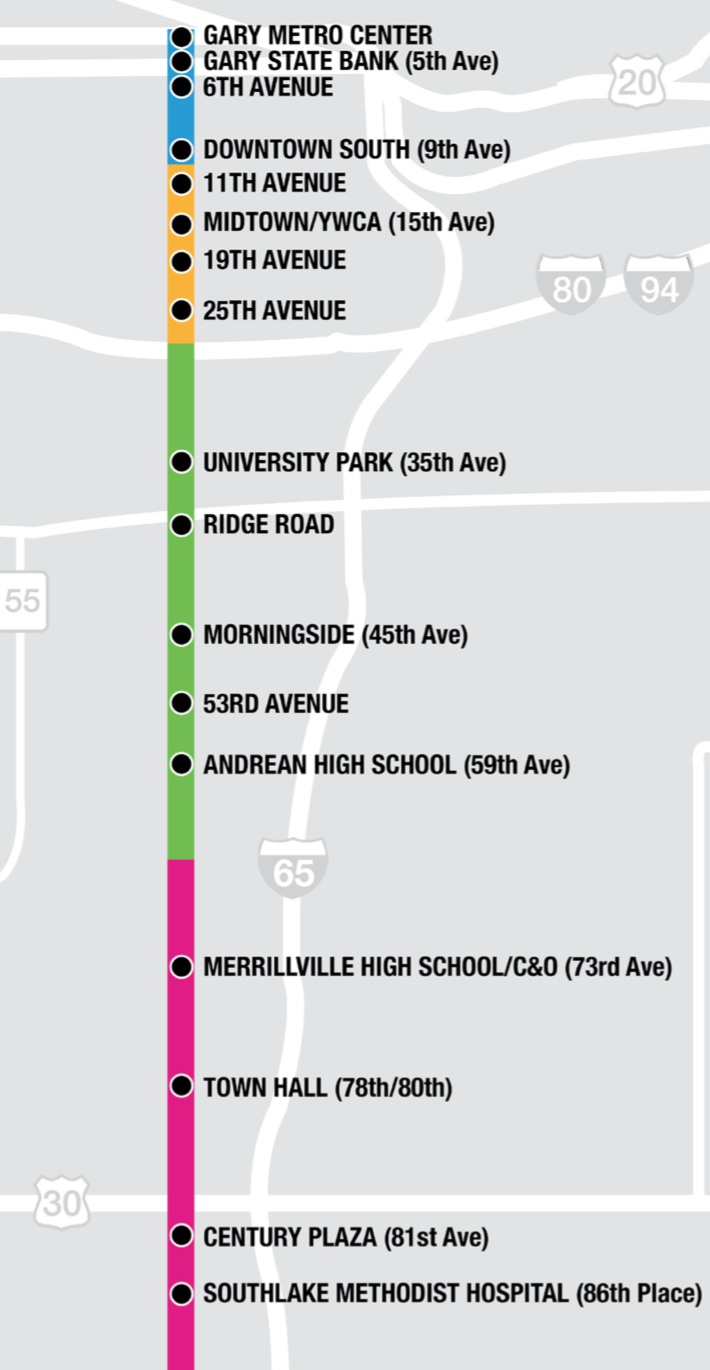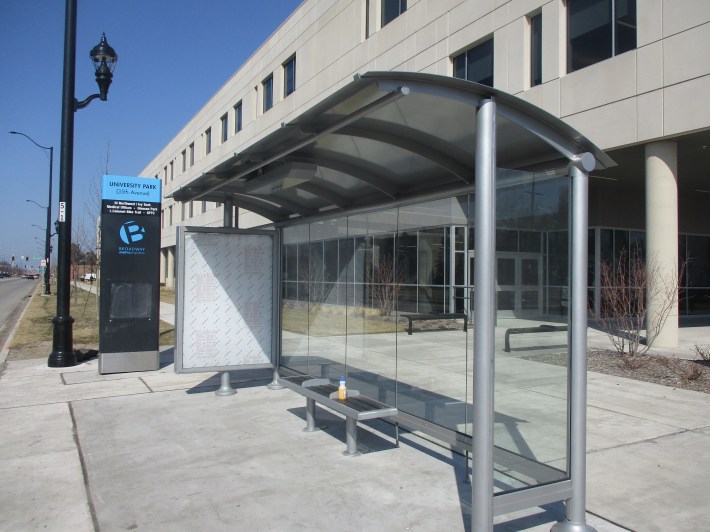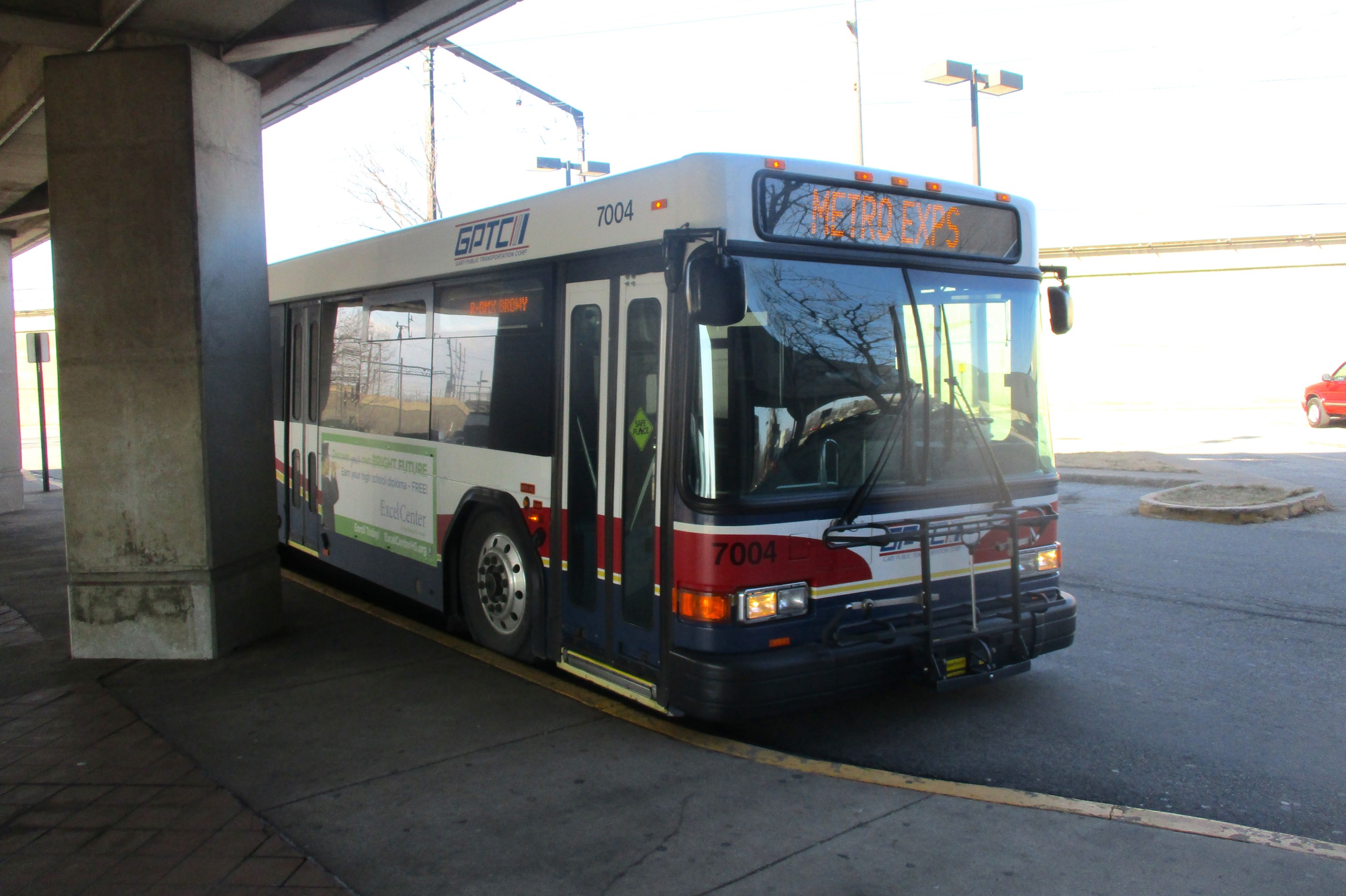GARY, IN – A month ago, on February 19, the City of Gary, Indiana, launched what it billed as its first "Rapid Bus" service – the Broadway Metro Express route.
It isn't bus rapid transit service with bus-only lanes or 'L' station-style stops. Rather, Gary Public Transportation Corporation launched a series of improvements designed to have buses run more often without much infrastructure work.
Many of those improvements fairly modest. Service frequency more than doubled to every 20 minutes. The bus stops got new shelters and more prominent signs that, in some cases, came with information about major destinations and the map of the entire route. And, in a first for the Northwest Indiana bus systems, the route follows only stops at the designated stops instead of letting passengers flag down the bus and get off the bus at any intersection.
But the new service also featured bus-only lanes in front of many stops – a rarity in Chicagoland. And, instead of simply making plans to improve service, GPTC started with a plan to improve all aspects of the corridor and developed Broadway Metro Express as just one of the many potential improvements. So as municipilities are planing to redevelop the corridor, they are taking the plan and the new bus service into account.

GPTC provides bus service in Gary and nearby Merrillville and Hammond, with limited service in East Chicago, Crown Point, Hobart and unincorporated Calumet Township. Metro Center is its hub – all of the routes within the city limits stop there, and there's a South Shore Line station, and stops for Greyhound, Trailways and Indian Trails inter-city bus services.
Dave Wright, the CPTC's Planning Manager said that the stretch of Broadway Avenue between 5th and 93rd avenues is not the busiest corridor in terms of vehicle traffic in general, but it is the system's busiest transit corridor. It is home to a number of colleges, hospitals, shopping areas, entertainment venues and government offices.
Before Broadway Metro Express was launched, there were two routes serving most of the corridor, routes 17 and 18. However, the two overlapped and meant riders who missed one route had to wait 30 minutes for a bus on the other route.
By contrast, GPTC commissioned the Livable Broadway development plan before it even started planning the express route. The idea was to work with the municipalities and regional organizations and devise development priorities and designing a service that would best complement it.
"We got of all our transit services going through Broadway," Wright said. "What we wanted to do is improve transit service and compliment possible land use and development improvements and make service more visible. And it's something that BRT elements can facilitate. [We thought] it would be great opportunity to bring BRT elements and increase capacity, so, as development takes place, we are already taking additional traffic into consideration.”

The agency was able to apply and ultimately obtained a grant to help fund the costs of setting up the service.
Broadway Metro Express (R-BMX) buses run once every 20 minutes between 7:00 a.m. and 6:00 p.m. and once every 40 minutes before and after that period.
The bus also runs later than the previous routes 17 and 18, which were eliminated. GPTC introduced two new local shuttles to cover the resulting service gaps and link to some nearby destination that didn't have direct transit service before.
When asked whether GPTR tried to match the schedule to South Shore Line arrival times, Wright explained that the fact that trains don't arrive at regular intervals made that impossible.
“We didn't try to sync up 'perfectly,' but the fact that we're able to bring more buses to the Metro Center more quickly means that people have more opportunities to link their trips from South Shore to Metro Express and vice-versa."
As Wright explained, R-BMX was a major adjustment for riders. Until it launched, riders could flag the bus down or request a stop at any intersection. The new service only drops off and picks up passengers at bus stops set up at major intersections and destinations.
"Even that change is something people need to get used to," Wright said. "We got volunteers, transit ambassadors, who are talking to riders and getting feedback from public."
The route makes it unique among region's services. Valparaiso's V-Line, East Chicago Transit, and Michigan City Transit follow the requested stop system, too. Meanwhile, all of Chicago's CTA buses follow the same “posted stop only” policy as R-BMX. Pace buses, which serve suburban Chicagoland and small portion of Hammond, mostly follows the requested stop system, but the transit agency has been gradually switching its routes to posted stop only in order to speed up service.
Wright explained that one of the goals of R-BMX service was to make the bus stops it does stop at more visible. At major destinations and some minor destinations, it does something similar to CTA's J-14 Jeffrey Jump stops – tall signs list major nearby destinations and show a route map next to a large shelter. Other stops are more modest, with a simple sign with a the service's custom logo and smaller bus shelters.
In order to speed up service, GPTC worked with Indiana Department of Transportation to add bus-only lanes near the bus stops to allow buses pull in and out of the lanes closer to the center. Full-fledged bus-only lanes are one of the GPTC's long-term priorities.
A recent trip along Broadway Metro Express showed that there were still some issues. Some of the bus stops don't have maps, and the bus shelter panels that were supposed to have artwork were empty. But mostly glaringly, finding schedule information isn't easy.
When CTA, Metra and Pace introduce new services, the new schedules are usually available online and in print before the service changes. By contrast, as of March 13, GPTC's official website still displays pre-February 19 schedules, and of of the new services, it only has the schedule for R5 shuttle. The only place to find them online is on the agency's Facebook page, in the comment section for the post announcing R-BMX launch.
When asked whether GPTC was thinking about bringing the rapid bus concept to any of the other routes, Wright explained that they were considering route 12-Lakeshore Connection. It links the Metro Center, Gary/Chicago Airport, and the cities of East Chicago and Hammond. It's currently the only link between GPTC and Pace bus system – the Pace routes that serve Hammond stop near its downtown Hammond stop.
"Down the road, if the ridership requires us to upgrade that [route], the Metro Express model is one of the first things we'll put, to see if it would fit the corridor,” Wright said.
The Gary and Northwest Indiana Regional Development Authority set up a program where businesses that are located on the corridor and want to improve their building facades would get 50 percent matching funds. "That is an active program that could actually improve businesses along corridor," Wright said.
And he said that, so far, aside from the learning curve that came with designated stops, the response has been positive. "Its still a learning process, but buses have been on time, for most part, and we've been getting a lot of positive feedback as well," Wright said.





